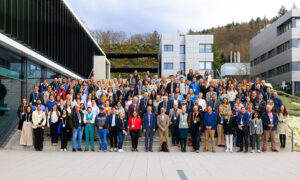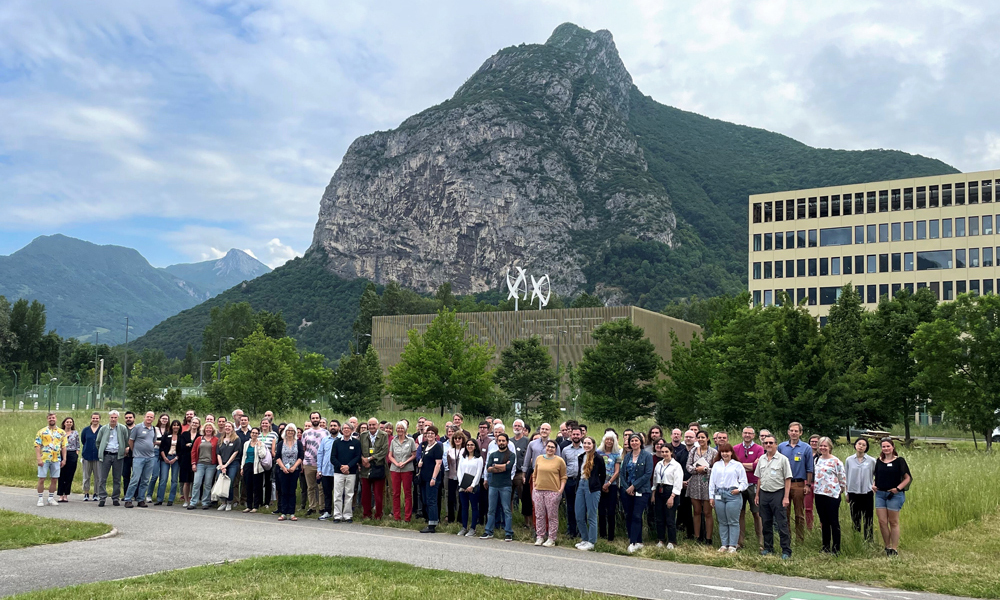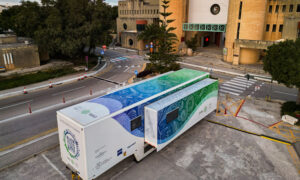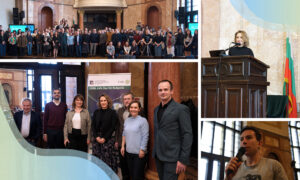
Looking back on 20 years of structural biology collaboration in Grenoble
The Partnership for Structural Biology offers a wide range of scientific platforms, training, and possibilities for collaboration to researchers based in Grenoble and beyond

On this date (15 November), 21 years ago, the EMBL, ESRF, ILL, and IBS signed a memorandum of understanding to create the Partnership for Structural Biology (PSB) on the European Photon and Neutron (EPN) science campus in Grenoble.
In May 2023, the four partner institutes celebrated the PSB’s 20th anniversary with a one-day event. This was a good opportunity to look back on the motivation for its creation, the many opportunities it has offered to the research community so far, and the next big challenges for the PSB.
The last edition of the PSB newsletter (September 2023) included a special feature on these different aspects and a brief history of the PSB, with interesting reflections from key people who initiated, shaped, and supported this partnership: Stephen Cusack (EMBL Grenoble), Rob Ruigrok (Université Grenoble Alpes, formerly at EMBL), Ed Mitchell (European Synchrotron Radiation Facility – ESRF), Eva Pebay-Peyroula (Université Grenoble Alpes, formerly at Institut de Biologie Structurale – IBS), and Trevor Forsyth (LINXS, formerly at Institut Laue Langevin – ILL).
Here we share some of their testimonials about the partnership’s achievements over two decades, highlighting the main missions of this cooperation:
Sharing scientific facilities and platforms
“The beauty of the PSB was that, by enhancing the quality, efficiency, and ease of access to advanced structural biology infrastructure, and regularly upgrading these facilities as institutional budgets permitted, it enhanced the visibility and attractiveness of the Campus for both external users and on-site scientists, all of whom could benefit from the PSB’s ‘uniquely comprehensive palette of structural biology techniques’.” – Stephen Cusack, EMBL, former Head of EMBL Grenoble
“Setting up common platforms is the most important achievement. We have now on site an ensemble of techniques that are remarkable. Among the instruments, the development of cryo-EM was the most impressive.” – Eva Pebay-Peyroula, Université Grenoble Alpes, former IBS Director
Putting together complementary research expertise
“With European Union funding (FLUPOL and FLUPHARM) and the PSB platform support, the Unit of Virus Host Cell Interactions (UVHCI) was able to answer fundamental questions on the Influenza polymerase, which is probably the best collective achievement so far. Now it’s time for the newer PSB groups to identify a new and exciting scientific challenge, whatever that may be.” – Rob Ruigrok, Université Grenoble Alpes, former EMBL Group Leader and co-Director of the UVHCI (a Unite Mixte International created by UJF-EMBL-CNRS from 2007 to 2016)
“It is possibly unwise to single out any one particular achievement given that the PSB had such a broad impact. (…) The PSB has played a pivotal role in the development of what is now widely known as Integrative Structural Biology.” – Trevor Forsyth, LINXS, former Head of the Life Sciences group at ILL
Enhancing training and scientific life on campus
“The creation of the PSB and CIBB* enabled the recruitment of several talented research scientists (…). This provided a critical mass of researchers that enabled the UVHCI to attract substantial external funding to tackle fundamental questions in influenza, rabies, measles, and Epstein-Barr viral biology. It was an exciting time with weekly scientific meetings in viral biology (…).” – Rob Ruigrok
“On another level, the PSB through its various animations, training, and outreach activities has contributed to creating a sense of identity amongst structural biologists on the EPN campus.” – Stephen Cusack
Facing challenges: what’s next?
“The best achievement of the PSB is inspiring other similar centres to be created. Now the PSB needs to look to what it wants to be, and must be, in 2030 – how to better serve science, and our user communities and drive solutions to real challenges that the world faces by drawing on and drawing together the extraordinary technologies and brains which make up the PSB.” – Ed Mitchell, ESRF
“There are several exciting things happening in structural biology at the moment. First, advances in single-particle cryoEM now make it possible to obtain structural snapshots of large complexes in action. Second, ongoing instrumentation developments and artificial intelligence (AI) assisted image processing are making feasible in-cell structural biology using cryoEM tomography and correlative microscopy, and at lower resolution, X-ray imaging. Then, protein dynamics, transient states, and disordered systems can be studied by advanced NMR and time-resolved methods such as serial X-ray crystallography. Finally, the application of AI to structure prediction, de novo protein design, and potentially drug development is opening up totally new methods and fields. The PSB is already engaged in several of these activities, but if it wants to keep itself at the forefront of structural biology instrumentation, methods, and service, it needs to develop a forward-looking strategy encompassing all these opportunities.” – Stephen Cusack
*The Carl-Ivar Brändén Building (CIBB) was inaugurated in 2006 on the EPN campus and hosts some of the four PSB partners’ scientists and associated technical platforms.
Related links
- Partnership for Structural Biology (PSB)
- PSB Newsletter, edition 31: PSB's 20th anniversary feature (pages 7 - 10)
- Partnership for Structural Biology: strength in diversity (agreement renewal, 2016)
- A major European Centre for Structural Biology inaugurated in Grenoble (opening of the CIBB building, 2006)


